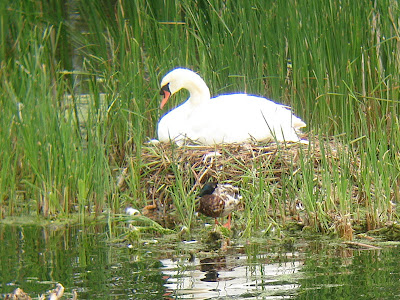The wind blew strong across the park pond on Friday 22nd accompanied at times with some heavy bursts of rain. The main noteworthy sight on the pond was an abandoned nest of mute swans eggs. Both adults were still present but the female was preening while the male was feeding. It has not been too much of a surprise since it was first noticed several months ago that the female was a young bird and didn't seem to have much maternal instinct.
Her pale bill could suggest she's only a couple of years old and very inexperienced. Hopefully she will return next spring with a stronger instinct and will have learnt how to sit gently down on the nest, where to place her big-webbed feet, ensuring all the eggs stay in the nest and the importance of keeping them continually incubated if the weather is cold and wet.
Andy Field had noticed a couple of marsh harriers over the fields near the pond during the morning. One had flown hungrily over the pools in the nearby field yesterday before being chased off by a lapwing. There was also a report of a coot chick being snatched off the pond recently by a marsh harrier.
Despite the windy and showery day, there was a continuous flow of swifts flying west over the park with a rough figure of about 500 birds passing over during a couple of hours in the middle of the day. On the grazing fields a juvenile grey heron and little egret were seen while 10 gadwall, single teal and 10 mallard were also present.
Two corn buntings were singing beside the East Mersea road near Bocking Hall and there was also a dead weasel on the road near Weir Farm.
Clive Walls and his wife reported the regular sight of turtle doves this spring in their garden near Willoughby car park in West Mersea with up to six turtle doves being counted on one day. Steve Entwistle enjoyed seeing 6 four-spotted chasers and 4 emperor dragonflies at Maydays Farm on Wednesday 20th. Also that day he'd seen 5 meadow browns at the park along with a red admiral butterfly.
On Tuesday 19th a smaller swift passage over the park was noted when around 50 birds were seen crossing over the river from Colne Point. A cuckoo flew along the clifftop calling and the nightingale was heard calling too. One adder was seen briefly by the track while a group of school-children were fortunate they spotted a green hairstreak butterfly on the ground in the car park, before it got trodden on.
As the sun was setting from the East Mersea Point on Monday evening, a marsh harrier flew down river, a sparrowhawk crossed west over the fields, 2 pairs of avocets were on the saltmarsh pools, while 5 little terns and 5 common terns hawked along the Colne river. Two black-tailed godwits, 20 gadwall and 10 mallard, including 2 ducklings were on the pools in the fields.
On the mudflats, 3 knot, 20 grey plover, 25 curlew, 5 little egrets were noted from the park, while 2 immature lapwings flew along the beach and there was an oystercatcher on the beach at the Point. A little owl flew out of a tree near the buildings in the car park after some persistent mobbing by blackcaps and jays.
This distinctive very white flower crab spider was seen on this flower in my garden. It's a common spider and is often seen on white and yellow flowers mainly, possessing the ability to change colour to match the flowers.
The moth trap was out a couple of occasions during the week with only the one soaking one morning. This buff-tip moth pictured above, dried out enough to pose on this twig, showing how it looks like a bit of twig itself.
Two small fan-foot moths were seen in the trap after Wednesday night.
The catch of moths noted on Wednesday night were 40 moths of 20 species. This included clouded silver, common white wave, mottled beauty, green pug, sandy carpet, straw dot, coxcomb prominent, white point, snout, dark arches, marbled minor, mottled rustic, vines rustic, common wainscot, shoulder striped wainscot, setaceaous hebrew character, flame, heart and dart and treble lines.



































